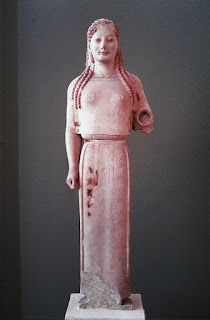Friday, October 22nd, 2010
The Un-Peplos Kore
Tonight I’ve been researching why the so-called “Peplos Kore” (c. 530 BCE, shown left) might not be wearing a peplos garment. (A “peplos” is a rectangle of cloth that is pinned at the shoulders and worn with a belt – it gives the effect that the woman is wearing a blouse. And “kore” means young woman; it is a name given to certain female statues made by the Greeks.)
This current “un-peplos” argument is based on recent reconstructions and studies of the figurine. Instead of a peplos, it is thought that the statue is wearing a long robe, cape, and an ependytes (an outer garment which is a metal-like sheath divided into regular, rectangular compartments).1 The ependytes was an Eastern garment associated with divine power, and therefore suggests that this figurine would have represented some type of goddess, perhaps Artemis or Athena.
This argument has been solidified by the recent reconstructions of the Peplos Kore by German archaeologist Vincenz Brinkmann.2 I suppose that now the problem is to try and ascertain which goddess could be depicted. The statue’s missing right hand probably held some object to help ascertain her identity (like a bow for Artemis). Brinkmann favors the idea that the goddess is Artemis (although alternate theories have been presented by others).3 Anyhow, here are some possible ideas presented in reconstructions of the Peplos Kore:
1 Richard T. Neer, The Emergence of the Classical Style in Greek Sculpture (Chicago: University of Chicago Press, 2010), 119. Source available online here.
2 Ibid. You also can read an English review of Brinkmann’s publication here (review by by Brunilde Sismondo Ridgway). Be sure to check out the penultimate paragraph and footnote #12 to find out more information about the Peplos Kore argument.
3 See Brunilde Sismondo Ridgway review (Bryn Mawr Classical Review 2004.08.07), footnote #12.




Very interesting M! It seems like you are still fascinated by the painted sculpture of antiquity.
These early Greek figures are so reminiscent of Egyptian sculpture – I wonder what degree of influence there may have been from Egypt to Greece.
H
I think it's interesting that some of these reconstructions have elements attached to the kore's head. Do you know if the Peplos Kore has any sort of markings that would indicate a piece attached to her head that had broken off? I guess I just always assumed that her head was in good enough condition to indicate that she wasn't wearing any kind of headpiece. Unless maybe it was made out of a different kind of material, like metal, and placed on her head as a separate piece. Anyway, I like how the various reconstructions each make her look so different.
Kiersten~I think there's a hole on top of her head or something like that. I know the head of Inanna from Uruk has a slot that held a wig or a crown.
The older reconstruction always makes me think the not-a-peplos kore has an umbrella sticking out of her head. 😉
Thanks for the comments! Yeah, Kiersten, there are a couple of holes where the kore would have had metal attachments. Brunilde Sismondo Ridgway mentions several holes in an article she wrote in 1977 ("The Peplos Kore, Akropolis 679" The Journal of the Walters Art Gallery," p. 56-57). In particular, she mentions that thirty-five holes (in two rows) surrounding the entire head. Some of these holes still preserve the lead pins which originally fastened the head ornament in place!
Ridgway discusses how the holes of the inner row are evenly spaced, whereas the outer row are spaced and irregular intervals. These detailed layout of holes seems to suggest that the head ornament was rather elaborate. Bridgway also mentions that there were remains of a meniskos (umbrella) found. Perhaps the statue had a head ornament and a meniskos.
Interesting. Thanks!